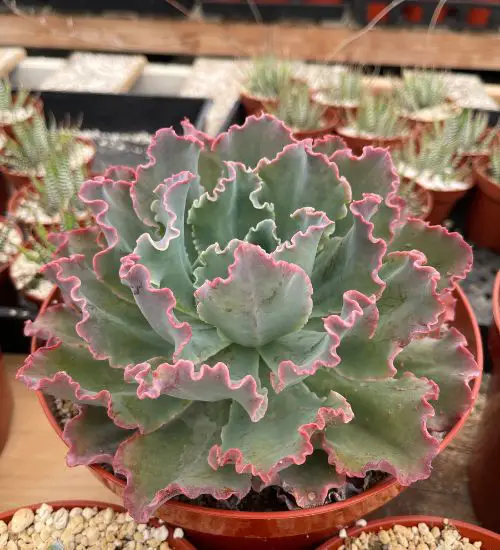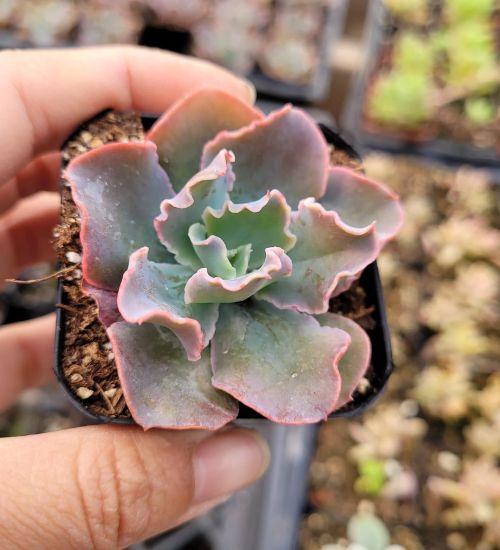Sun: Full sun to light shade
Water: Typical water needs for a succulent
Temperature: Zone 9a from 20° F to 25° F (-6.7 ° C to -3.9° C) to Zone 11b from 45° F to 50° F (7.2° C to 10° C)
Winter Survival: Cold hardy to 0°C
Propagation: leaves, offsets, seeds
Flower: in the summer
Flower Type: pink, red-pink
Toxic: Generally non-toxic to humans and animals
Dormant: winter
Space Requirement: Outdoors
Common Problems: Plants may rot if overwatered, pests
Where to buy Echeveria Blue Curls?
Basc Care for Echeveria Blue Curls
Watering
You can water your succulent more than often in extreme conditions but make sure that the soil is completely dry before watering your succulent again.
One simple tip for you is that you can use some online apps to check the soil status before you go water your succulents. I would recommend the ThePlantsCheck app, it has some nice features there.
Fertilizing
Only feed this succulent during its active growing seasons which means winter. Use the right fertilizer applied in the right amounts. Applying half-strength balanced fertilizer every month or so is recommended for optimal results.
Do not fertilize during winter as the plant is dormant.
Sun & Location Requirements for "Echeveria Blue Curls"
When giving Echeveria Blue Curls its ideal environment, remember to provide it with full sun to light shade. This means that it should receive at least 6 hours of direct sunlight each day, with no more than 5 hours of shade during the hottest portions of the day.
As per this succulent profile, it is only able to stay healthy when the environment temperature is above the range of zone 9a from 20° F to 25° F (-6.7 ° C to -3.9° C).
Echeveria Blue Curls is a cold-hardy variety that can survive temperatures as low as 0°F. It has adapted to its environment by developing thick, succulent leaves and stems that are able to retain moisture in winter months. Its fleshy leaves also help protect the plant from extreme cold temperatures, allowing it to survive even the harshest cold conditions.
Any succulents in the group will need a large space to grow. You should place your pot outdoor. Since this plant needs a lot of space than other succulents, you should consider not planting them together with other succulents/plants.
Echeveria Blue Curls also benefits from some indirect light throughout the day as well, so make sure you give it enough space to soak up light without becoming too exposed to heat.
Propagation
Growing succulents from leaves is an enjoyable and rewarding experience. All it takes is a few healthy leaves, some potting mix, and regular watering. Soon you'll have beautiful new succulents that are a product of your effort!
Offsets are an easy and reliable way to propagate succulents, like Echeveria Blue Curls. With just a few simple steps, you can get a brand-new plant from an existing one.
Echeveria Blue Curls can be propagated from seeds. Signs of a good seed is one that is plump, dark in color and slightly sticky. To propagate X from seed, one must prepare a soil mixture of well-draining potting mix, sow the seeds evenly and lightly press them into the surface. Lastly, gently water the soil using a spray bottle and place the container in bright but indirect light.
Toxicity

Echeveria Blue Curls is not known to pose any significant health risks, as it is not considered to be toxic. However, it is best to keep the plant away from young children and pets, as they may ingest some of the parts of this plant that could contain toxins which can cause mild skin irritation.
Pests and Diseases
Echeveria Blue Curls can be affected common pests and diseases like most of the other succulents such as aphids and mealybugs.
If you do spot any of pest signs, you can treat your succulent using below methods.
- Aphids: quarantine, clean infected plants, soapy water.
- Mealybugs: quarantine, clean infected plants, soapy water.
Besides that, to prevent serious health issues from happening, keep your succulent in a well-ventilated area and check it regularly for any signs of pests or health problems.


